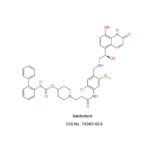Batefenterol (GSK-961081)
$120.00 – $700.00
GSK-961081 (Batefenterol, TD-5959) (CAS No.: 743461-65-6), Novel Muscarinic Receptor Antagonist and β223298% Purity.
Synonyms: GSK-961081, TD-5959, Muscarinic Receptor Antagonist, β2For Research Use Only.
- Product Details
- Description
- More Offers
Description
APIM050405: Batefenterol (GSK-961081, TD-5959), CAS No. 743461-65-6, a Novel Muscarinic Receptor Antagonist and β2232
CAS No.: 743461-65-6
IUPAC/Chemical Name: (R)-1-(3-((2-chloro-4-(((2-hydroxy-2-(8-hydroxy-2-oxo-1,2-dihydroquinolin-5-yl)ethyl)amino)methyl)-5-methoxyphenyl)amino)-3-oxopropyl)piperidin-4-yl [1,1′-biphenyl]-2-ylcarbamate
Molecular Formula: C40H42ClN5O7
Molecular Weight: 740.25
Purity: >98% (or refer to the Certificate of Analysis)
QC: Achiral and Chiral HPLCs, MS, NMR, and Quantitative Elemental Analysis Report
Solubility: Soluble in DMSO
Storage: Dry, dark and at 0 – 4 oC for short term (days to weeks) or -20 oC for long term (months to years).
Note: Please contact us for COA, Spectra, and SDS information.
Background Information:
Chronic obstructive pulmonary disease (COPD) is a chronic inflammatory condition that is characterized by progressive airflow limitation caused by a mixture of small airway disease and parenchymal destruction. Bronchodilators form the cornerstone of symptomatic pharmacologic management for patients with COPD. These medications, which are usually dosed by inhalation to reduce systemic adverse effects, are administered on an as-needed basis for persistent or worsening symptoms or on a regular basis to prevent or reduce symptoms. Two classes of inhaled bronchodilators, b2-adrenoceptor agonists (BAs) and muscarinic receptor antagonists (MAs), are currently available for use in the treatment of COPD. MAs and BAs cause bronchodilation through distinct but complementary mechanisms that potentially synergize with each other given the functional “cross-talk” between M2/M3 muscarinic
and b2-adrenoceptors in airway smooth muscles. MAs relax airways by reversing cholinergically-mediated bronchoconstriction via antagonism of M2 and M3 muscarinic receptors on airway smooth muscle. BAs cause direct relaxation of airway smooth muscle tissue. Both MAs and BAs improve lung function and health-related quality of life while reducing symptoms, including COPD exacerbations. In clinical practice, patients with moderate-to-severe COPD are usually prescribed more than one bronchodilator. This usually includes a long-acting muscarinic antagonist, such as tiotropium, and a long-acting bronchodilator (LABA), such as salmeterol or formoterol. Several studies have demonstrated that the combination of a MA and BA, in separate inhalers, provides greater improvement in lung function than either single agent alone. In patients with severe-to-very severe COPD who have repeated exacerbations, inhaled corticosteroids are frequently added to the treatment regimen of a MA and BA to achieve triple therapy.[1]
GSK-961081 (TD-5959, batefenterol, CAS No. 743461-65-6) is a novel inhaled bifunctional compound that was designed to exhibit dual muscarinic antagonist and b2-adrenoceptor agonist (MABA) pharmacology with the potential to deliver optimal bronchodilation after inhalation dosing via two validated mechanisms in one molecule. Compounds with MABA activity offer a single pharmacokinetic profile for both pharmacologic activities, thereby maximizing the potential synergy between the two mechanisms, which would otherwise be difficult to achieve with coadministration of two separate compounds with distinct pharmacokinetic-pharmacodynamic profiles. In addition, given the technical challenges associated with coformulation of two or more compounds in a single device, a MABA offers a conceptually simpler technical path toward achieving triple therapy in one device. A potential limitation of the MABA approach is that the fixed MA/BA potency ratio in a single dual pharmacology compound precludes one from varying the relative activity at the two targets, a goal that is more readily achievable with a combination of two separate drugs.[1]
GSK-961081 displays dual MABA pharmacologic properties and produces potent and long-lasting bronchoprotection in guinea pigs accompanied by minimal systemic MA and BA effects. These findings have been borne out in the clinic as inhaled GSK-961081 produced robust 24-hour bronchodilation without clinically relevant MA or BA systemic effects in COPD patients.[1]
Synthetically, GSK-961081 (TD-5959, batefenterol) and its analogues were synthesized in five steps from commercially available materials.[2]
Target: hM2, hM3, β2
Ki: 1.4 nM (hM2), 1.3 nM (hM3), 3.7 nM (β2)
In Vitro: Batefenterol (GSK-961081, TD-5959) is a novel first-in-class inhaled bifunctional compound possessing both muscarinic antagonist (MA) and β2-adrenoceptor agonist (BA) properties (MABA). In competition radioligand binding studies at human recombinant receptors, batefenterol displays high affinity for hM2 (Ki=1.4 nM), hM3 muscarinic receptors (Ki=1.3 nM) and hβ2-adrenoceptors (Ki=3.7 nM). Batefenterol behaves as a potent hβ2-adrenoceptor agonist (EC50=0.29 nM for stimulation of cAMP levels) with 440- and 320-fold functional selectivity over hβ1- and hβ3-adrenoceptors, respectively. [1]
In Vivo: In the guinea pig bronchoprotection assay, inhaled batefenterol (GSK-961081, TD-5959) produces potent, dose-dependent inhibition of bronchoconstrictor responses via MA (ED50=33.9 µg/mL), BA (ED50=14.1 µg/mL), and MABA (ED50=6.4 µg/mL) mechanisms. Significant bronchoprotective effects of Batefenterol are evident in guinea pigs via MA, BA, and MABA mechanisms for up to 7 days after dosing[1]. In guinea pig isolated trachea expressing native muscarinic M3 and β2, batefenterol produces smooth muscle relaxation through a dual mechanism involving competitive antagonism of the M3 receptor (EC50=50 nM) and agonism of the β2 receptor (EC50=25 nM). The combined effect on both muscarinic receptors and β2 receptors is more potent than either function working alone (EC50=10 nM). Batefenterol exhibits a rapid rate of clearance and short half-life. [2]
What is the solubility of GSK-961081 (TD-5959, batefenterol) in vitro?
DMSO: 100 mg/mL
What is the solubility of GSK-961081 (TD-5959, batefenterol) in vivo?
1. Solvent: DMSO, PEG300, Tween-80, and saline
Please add 10% DMSO, 40% PEG300, 5% Tween-80, and 45% saline in order; solubility ≥ 2.5mg/mL.
2. DMSO and corn oil
Please add 0% DMSO and 90% corn oil in order, solubility ≥ 2.5 mg/mL.
Reference:
[1]. Hegde, S. S. et al. “Pharmacological Characterization of GSK-961081 (TD-5959), a First-in-Class Inhaled Bifunctional Bronchodilator Possessing Muscarinic Receptor Antagonist and β2 Adrenoceptor Agonist (MABA) Properties”, J. Pharmacol. Exp. Ther., 2014, 351, 190-199
[2]. Hughes, A. D. “Discovery of (R)-1-(3-((2-chloro-4-(((2-hydroxy-2-(8-hydroxy-2-oxo-1,2-dihydroquinolin-5-yl)ethyl)amino)methyl)-5-methoxyphenyl)amino)-3-oxopropyl)piperidin-4-yl [1,1′-biphenyl]-2-ylcarbamate (TD-5959, GSK961081, batefenterol): first-in-class dual pharmacology multivalent muscarinic antagonist and β₂ agonist (MABA) for the treatment of chronic obstructive pulmonary disease (COPD)”, J. Med. Chem. 2015, 58, 2609-2622
[3]. Pulido-Rios, M. et al. “TD-5959: A Novel Bifunctional Muscarinic Antagonist – β2-Adrenergic Agonist with Potent and Sustained In Vivo Bronchodilator Activity in Guinea Pigs”, Am. J. Respir. Crit. Care Med. 2009, 179, A6195.
Frequent questions related to “Batefenterol (GSK-961081, TD-5959), a Novel Muscarinic Receptor Antagonist and 2
Who makes Batefenterol (GSK-961081, TD-5959)?
What is Batefenterol (GSK-961081, TD-5959)?
What is the mechanism of action for Batefenterol (GSK-961081, TD-5959)?
Popular searches related to “Batefenterol (GSK-961081, TD-5959), a Novel Muscarinic Receptor Antagonist and 2
Batefenterol (GSK-961081, TD-5959) results
Batefenterol (GSK-961081, TD-5959) fda approval
Batefenterol (GSK-961081, TD-5959) mechanism of action
Batefenterol (GSK-961081, TD-5959) price
Batefenterol (GSK-961081, TD-5959) side effects
Batefenterol (GSK-961081, TD-5959) CDK9 Inhibitor
Batefenterol (GSK-961081, TD-5959) synthesis
Batefenterol (GSK-961081, TD-5959) analogue
Batefenterol (GSK-961081, TD-5959) structure activity study
Batefenterol (GSK-961081, TD-5959) in vitro
Batefenterol (GSK-961081, TD-5959) in vivo
Batefenterol (GSK-961081, TD-5959) supplier
Batefenterol (GSK-961081, TD-5959) clinical study
KB-0742 CDK9 inhibitor
KB-0742 Cyclin-dependent kinase 9
Batefenterol (GSK-961081, TD-5959) Cytotoxicity
Batefenterol (GSK-961081, TD-5959) Target
Batefenterol (GSK-961081, TD-5959) Muscarinic Receptor
Muscarinic Receptor
Adrenoceptor Agonist
Batefenterol (GSK-961081, TD-5959) Adrenoceptor Agonist
CAS No 743461-65-6 Price
CAS No 743461-65-6 Supply
CAS No 743461-65-6 Cheap Price





